
Sections The Internet: Up to Speed, Fast Why Now? Enablers and a Killer App Coming Applications Internet Hardware: Wild, Crazy, and New Coming Soon: The Thin Client Keeping it Simple: A Web Server Appliance Completing the Architecture: The Net Utility Box THiiN Line: Computers for the Information Age The Internet has taken the world by storm. For computer professionals everywhere, it's brought surprise, created havoc, and opened startling opportunities. And it's not over; many would say it's barely started. The Internet possesses a force that could eventually transcend the traditional borders — in technology, geography, and politics. This paper describes Data General's view of how new, Internet-targeted products may evolve, and how they may be able to help key infrastructure participants serve the coming generations of users who will be living and working within this new and very curious electronic paradigm.
The Internet: Up to Speed, Fast 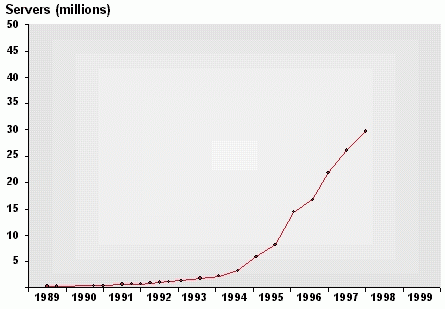
Source: Network Wizards What do we know? Computer industry experts know that the Internet, which began as the Defense Department's Arpanet, has doubled in size every nine to 12 months since its measurement began. A worldwide network of just a few hundred thousand hosts in 1990 rocketed to nearly 30 million hosts by early 1998, with an estimated user population of 56 million. But the point goes beyond large numbers: the Internet is growing not incrementally, it's growing geometrically.
Why Now? Enablers and a Killer App The enablers:
By themselves, these factors were not enough to bring about the Internet phenomenon as quickly and surely as it has emerged. Needed was a new user interface, one that was designed for viewing information: the browser. The web browser is the new killer app. It restores the idea of simplicity to computer operations. It succeeds because of its narrow-mindedness in doing one thing — accessing information — very well. Compare this to the killer apps of yesterday, the spreadsheet and word processor. They were able to arrange data for presentation in a “paper” format, one that mimicked the way users worked. But today's Internet users are different. Paper is too slow, too restrictive; data-on-paper is one-dimensional. Today's users want information, experience — text/audio/video, via the Internet. For presenting such multi-dimensional, dynamic information, the ideal user-interface format is no longer paper. It is glass.
Coming Applications At the consumer level, entrepreneurs are already reaping rewards by making information — on books, records, history, statistics, and other topics — available via glass. The coming availability of secure electronic cash will add a major impetus to Internet commerce. And the incentive for creating new consumer applications remains powerful. Currently, it is estimated that nearly 40 percent of the 98 million U.S. households own at least one PC. As for small business, the simplicity, economy, and efficiency of the Internet will offer substantial benefits. With the Internet, a small business gets a ready-made WAN/LAN communications network — and a host of new productivity applications — for not much more than the price of the modem. And for just a little more money, that business can put up its own web page and share the HTML-leveled field with far larger competitors. But the best applications may be those that don't exist and are not even being anticipated. The Internet promises to be “wild and crazy.” Success will go to those who see the nature of its impact as exponential, rather than incremental. More to the point, success will go to those who can face up to the immensity of change that the Internet may bring. Data General believes that history can be an effective predictor of the future; if the current Internet growth curve continues, by the year 2000, the network could be supporting 500 million clients, with nearly 100 million host servers.
Internet Hardware: Wild, Crazy, and New Now is an ideal time — and an important opportunity — to go beyond customary new-product design, where incremental improvements are applied to existing architectures. More than a luxury, innovation will become a competitive necessity. Ultimate success with Internet products will demand new thinking — about applications, work styles, and computer hardware. General-purpose computers, ever bigger, faster, and more complex, will not work in the new paradigm. Small, inexpensive, special-purpose devices, unencumbered by complex hardware/ software architectures, will be better suited to tomorrow's Internet applications.
With the Internet, general-purpose computers may soon reach an evolutionary
cul-de-sac, where the business of creating increasingly complex software in order to rationalize existing hardware is no longer necessary or viable. Instead, new devices will appear as special-purpose appliances:
uncomplicated, reliable, inexpensive, and dedicated to doing individual tasks.
Coming Soon: The Thin Client The thin client will bring the wonders of Internet communications to people for a fraction of the cost — and the effort — of today's traditional desktop viewing device, the PC. For many users, the thin client will be a clear choice over the PC because it promises:
It's easy to see why the concept of a low-overhead device — the thin client — is so attractive to companies, particularly in industries with fixed-function applications such as retail, travel, health care, financial services, and telecommunications. But the real thin client, an appliance that will take its intelligence from the network and won't bother with hard disks, load devices, or inter-dependent software, is arguably still a generation away from reality. Several of today's network computers represent a positive beginning for an exciting evolutionary curve.
Keeping It Simple: A Web Server Appliance At Data General, we call ours SiteStakTM. It is optimized to do one thing fast and well: move HTML pages onto the net. Designed to attach close to the Internet backbone, it acts as a high-speed Network Attached Storage Device (NASD), employing sophisticated content-aware caching for spectacular performance.
SiteStak will host a single large web site, or many, many smaller sites.
To add more capacity, simply add another SiteStak to the rack. It's that simple. In contrast, expansion can be a major problem for general-purpose computers in a content-hosting environment, since it adds to the already nearly unmanageable complexities these systems face every day. The cheaper, easier, more elegant solution is to use information server appliances. SiteStak is the first in a series of appliances designed to do the content-host's work. Other appliances might include archive managers, which maintain distant-memory files for SiteStaks, or search-engine specialists, which perform rapid searches of all content indexes.
Completing the Architecture: The Net Utility Box The net utility box is the simple solution to the need for thin client-based communications capabilities. Alternatives to the NUB, adding networking functions to thin clients, for instance, or adding intelligence to the network infrastructure, bring back the specter of technological complexity — the old model. The net utility box is the new model. It will be very small, inexpensive, and will contain router, hub, file and print-server functions. It will act as a wireless groupware platform for all devices in the home or office: thin clients, PCs, notebooks, printers, and other peripherals. The instant a thin client is switched on, the NUB will wake up, dial a phone line and connect to the Internet — all within a few seconds. Some likely net utility box applications:
THiiN Line: Computers for the Information Age For computer users, vendors, financiers, educators, government and business professionals, and “civilians” around the world, the Internet is a potentially confounding challenge: one whose time has come very suddenly; one that cannot be ignored. At the same time, the Internet presents the entire computer industry with an opportunity to do things differently, or to languish in the face of change. Data General established the THiiNTM Line Business Unit to design and market server-level Internet appliances. The first products are due for release in the second half of 1997. THiiN Line products will be especially valuable to the new legions of content hosts, the ISPs (Internet Service Providers), the RBOCs (Regional Bell Operating Companies) and the long-haul telecomm carriers, traditional suppliers of network bandwidth. Thanks to the coming Internet-optimized infrastructure products, these companies will be able to sell and manage their clients' content without having to manage complex arrays of traditional server systems.
THiiN and SiteStak are trademarks of Data General Corporation. All other brand and product names may be trademarks or registered trademarks of their respective holders. The materials contained herein are summary in nature, subject to change, and intended for general information only. Details and specifications regarding Data General equipment and software are included in the applicable technical manuals, available from local sales representatives. All rights reserved. Copyright Data General 1996. Back to Top |
||||||||||||||||||||
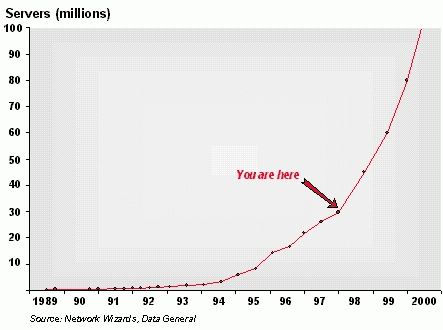
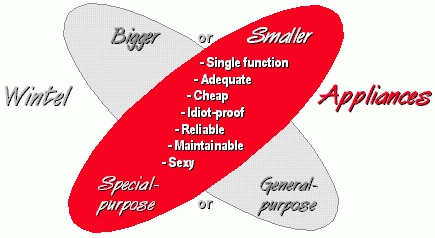
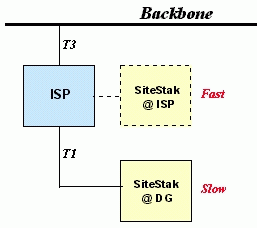
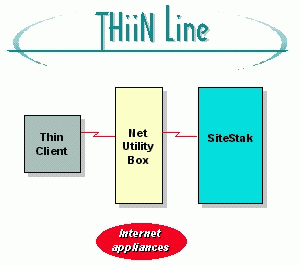 For these companies and other, Internet-savvy entrepreneurs,
Data General's THiiN Line products will prove an
advantage in the fight to gain some measure of control over the “wild
and crazy” Internet, and to make the most of the opportunities it will
bring.
For these companies and other, Internet-savvy entrepreneurs,
Data General's THiiN Line products will prove an
advantage in the fight to gain some measure of control over the “wild
and crazy” Internet, and to make the most of the opportunities it will
bring.